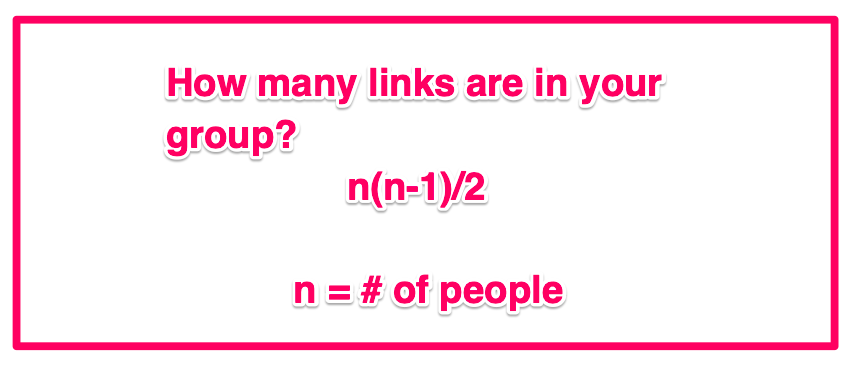
[Source: Amazon]
Jeff Bezos is prolific. In 21 letters to his investors over the years, he has delivered dozens of nuggets of wisdom ranging from prioritizing long-term outcomes over short-term results to embedding R&D in every single department.
He also has a unique take on company communication.
Bezos believes that no matter how large your company gets, individual teams shouldn’t be larger than what two pizzas can feed. Jeff Bezos hires any employees by keeping this in mind.
Think of it this way:
At a large party, it’s hard to connect with people. You’re overwhelmed by the number of guests you could possibly meet and converse with. You end up with more — yet more shallow — interactions.

If the host is trying to project a message to the crowd, he or she might have trouble shouting over the din.
In contrast, at a small party, you might talk to the people sitting next to you for hours. You can develop more meaningful relationships and maybe come away with new ideas and inspiration.
The two-pizza team approach emphasizes “creating teams with fewer people” to drive effective decision-making and collaboration.
Although Bezos first declared the “two-pizza” rule in Amazon’s early days, it continues to resonate in 2023. As the pace of venture capital accelerates, and more and more companies enter hypergrowth, figuring out how and when to design teams for effective communication becomes critical.
Not convinced? Here’s the hard evidence behind why the two-pizza team rule holds true.
Communication Becomes a Nightmare as Teams Expand
The issue with quickly growing teams isn’t quite the team size itself. As an organizational psychologist and expert on team dynamics J. Richard Hackman pointed out, that it’s the number of links between people that begins to pose the problem.
Look at the formula for determining the number of links between members in a group: n(n-1)/2.

As group size increases, the links start to get unwieldy.
- If you take a basic two-pizza team size of, say, six. That’s 15 links between everyone.
- Double that group for a team of 12. That shoots up to 66 links.
- A small business of 50 people has an incredible 1,225 links to manage.

The cost of coordinating, communicating, and relating with each other snowballs to such a degree that it lowers individual and team productivity.
Hackman explained, “The larger a group, the more process problems members encounter in carrying out their collective work …. Worse, the vulnerability of a group to such difficulties increases sharply as size increases.”
You want to be sure that your team is able to remain decentralized and move fast. Breaking into smaller pods as companies scale encourages greater autonomy and creativity. Not to forget, communication is the key aspect of great team bonding.
Finding tools to help you manage your teams is essential. Find a local computer repair professional to help you source and configure a platform that will work for you.
Two-Pizza Teams Protect Against the Team Scaling Fallacy

Many managers and team leaders fall into the mental trap that adding more people to a team is always good — especially in times of expansion. People are your best assets, so adding more assets to a project should power up progress right?
The fact is that a larger team size makes people overconfident. People have a tendency “to increasingly underestimate task completion time as team size grows,” researchers Bradley Staats, Katherine Milkman, and Craig Fox explain.
In one of their experiments, they discovered that when tasked to build the same Lego figure, two-person teams took 36 minutes while four-person teams took 52 minutes to finish — over 44% longer. Yet the bigger teams or large teams were almost twice as overoptimistic about how long they’d take.
When a project is running behind, you want to get something done faster, or there’s an ambitious milestone at stake, it seems reasonable to add on more people power.
Sticking to a maximum number of a two-pizza team will balance a natural tendency to underestimate the costs and friction of dealing with those extra links.
The Dangers of an Outsized Executive Team

The two-pizza team rule applies to the C-Suite as well. This group can quickly become a burden without the right checks and balances. Recent research from Harvard Business School highlighted how the number of individuals in C-Suites has doubled since the 1970s.
The rise of new positions like the Chief Technology Officer, Chief Information Officer, Chief Sustainability Officer, and Chief Supply Chain Officer has had companies scrambling to create and fill these roles in order to keep up. The result — in many cases — is top-heavy organizations.
In this scenario, decision-making can be onerous. With so many stakeholders, each empowered in different ways, reaching a consensus can take far longer than it would with two or three voices.
While a diversity of opinions and backgrounds is a good thing, there are ways to organize leadership to make sure the most important discussions remain targeted and efficient.
To keep the C-Suite to a two-pizza team:
- Look at the success rate of new C-Suite positions among your peers.
Is a Chief Sustainability Officer or Chief Digital Officer worth it? Could this be a corporate initiative instead of a salaried role? - Replace full executive positions with “sub-committees.” Take their voices into account, but don’t put them on par with your senior team leaders.
- Rely on outside advisors to help you see which executive roles are most important to your company mission — and which you could do without.
Any tactics you can take to remove bottlenecks, noise, and frustration in the top ranks will go a long way toward making your entire team more productive.
* * * * *
Trying to find your two-pizza team magic? Here are three tips to get you started:
1. What’s the magic number?
Bezos’s two-pizza rule works out to at most six or seven non-ravenous people. Teamwork expert Hackman pegs his magic number at five and fervently warns against going above 10. Management expert Bob Sutton cites the U.S. Navy Seals as having learned that four “is the optimal size for a combat team.”
Product analytics company Amplitude believes for an expanding startup, a growth team should be 5-10 dedicated teammates.
It’s safe to say that small teams count sticks to single digits, so start thinking of splitting into subgroups when you get beyond 10 people.
2. Follow the Cheers rule of effective teams.
Relational loss is a perception — so the more you can do to bring your team member together, the better your team will be.
With thousands of employees, Zappos puts a lot of thought into scaling the same strong culture, familial atmosphere, and tight-knit feeling that it had when it was such smaller team. It even hacked together a “face game” — when you log into the computer system, an employee’s face and bio pop up and you guess the person’s name.
The smaller startup, Karma, follows the Cheers rule by eating family-style lunches together every day.
3. Make teamwork easier through transparency.
According to Hackman, one crucial support structure found with effective teams is “an information system that provides teams the data and forecasts members’ need to proactively manage their work.”
Every jump in relational links as groups get larger opens the door to more miscommunication and misinformation.
Providing self-service transparency through systems, processes, and tools helps distribute information and power, so individuals can get aligned and move forward together as a team.
P.S. If you liked this article, you should subscribe to our newsletter. We’ll email you a daily blog post with actionable and unconventional advice on how to work better.

